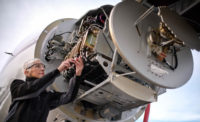Better Inspection Reporting
Automatically create inspection reporting for any industry.

The aerospace industry wouldn’t function without first article inspection.
According to SAE, “The purpose of the First Article Inspection is to provide objective evidence that all engineering design and specification requirements are properly understood, accounted for, verified, and documented. The purpose of this standard is to provide a consistent documentation requirement for aerospace components First Article Inspection.”
The organization goes on to say that “It is intended that the documentation generated will be a quality record of the supplier and customer for review of accountability and planning, for performing periodic surveillance and audits to verify conformance, for evaluating root cause and corrective action for any non-conformances, and for problem investigations.”
With many processes, software can make the job easier—and inspection reporting is no different. Aerospace, automotive and medical industries require stringent quality assurance, which, for everyone’s health and safety, involves plenty of documentation.
The importance of documentation should be clear to those in the quality field. And most companies understand that quality issues are best prevented, and as early as possible.
“If they miss something, or have a quality escape, you’re in trouble,” says Jake Hart, director of sales and marketing, at DISCUS. “They don’t want to have that happen. It’s really easy to lose a contract over that.”
The DISCUS software can help companies save time and money in inspection reporting, Hart says. Filling out aerospace forms, such as AS 9102 version B, can be done faster and more efficiently, with less errors. In some cases, this would be up to 70% faster than the manual process. Basically if a company has to have inspection reporting, the software takes the manual work out of creating the form they need to put together.
Previously someone would have had to balloon a drawing and manually enter information through an Excel spreadsheet. “We do all of that within the software. It removes a lot of the manual entry that they would have to have to go through,” Hart explains.
For drawings with 40-50 characteristics, this might take a short time. But some drawings many have an exponentially larger number. Consider that some drawings may have 2,200 characteristics. It would be easy to miss one.
With auto ballooning and other features such as error proofing (known in DISCUS as whiteout), it’s possible to create revisions very quickly. A user could revise the drawing without starting from scratch. Instead, they could use the existing data and make revisions from there.
Since the aerospace standard doesn’t change very often, complying with the standard should be second nature for experienced operators.
In training to use the software, it takes a little bit of training to demonstrate how to use it. The more automatic a system can be, the better. Automation ballooning, for example, is one feature that saves time.
“Everything is about speed and accuracy,” says Hart. People want their report to deliver more accurate characteristics,
This software offers different modules. For example, the CMM module would allow operators to bring results right from their CMM. In other words, they wouldn’t have to manually enter information. With the 3D module, it also would be possible to extract the geometry right from an uploaded 3D model within the DISCUS software. No extra software add-ons would be needed.
Optical character recognition, or OCR, is another notable feature. When using this OCR, operators don’t have to type in data. Instead it’s possible to open an Excel spreadsheet and transfer the information to the report.
Depending on how customers want the data, it is possible to have all of the information behind their firewall, not on the internet. The software can accommodate that for clients using higher security restrictions, such as suppliers working with the Department of Defense.
For those interested in trying out the software, it’s possible to download the product for a 30-day evaluation. Users would receive several hours of training, along with instructional videos and manuals.
Some people may be switching software if they didn’t like their current system or found it was lacking some features they wanted. Others may have decided to try first article inspection software after growing tired of manual reports.
Customers often have similar questions. Many times they want to know how to balloon and export to their own customized template. Each industry—whether medical or aerospace or anything else—has a variation of the inspection form, and companies can tailor the template to their specific needs.
The software serves some of the largest OEMs as well as some of the smallest. So it would be suitable whether you’re part of a multinational or the quality manager and the janitor and also the owner. For example, the company may sell one suite at a time, or as many as 350.
Inspection reporting is a key component of quality. It is important and necessary, but it doesn’t have to overly time-consuming if you have the right tools.
Looking for a reprint of this article?
From high-res PDFs to custom plaques, order your copy today!






